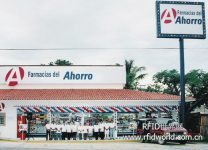
Mexican pharmaceutical chain stores adopt RFID on a large scale to track all branch assets
[ad_1]
The Mexican pharmaceutical chain Farmacias del Ahorro uses nearly 40,000 high-frequency RFID tags and 40 handheld readers to track inventory assets in its 700 pharmacies and 3 warehouses. Farmacias del Ahorro has achieved steady growth in the past few years. However, with the increase in the number of branches, asset management has also become a problem. The company now uses RFID to track every asset in each branch, from office equipment to scales.

Mexican pharmaceutical chain Farmacias del Ahorro
Farmacias del Ahorro and Nauter Technologies, a software development and system integration company, jointly developed this large-scale application. This system uses Tracient Technologies’ Padl-R HF reader. The reader reads a 13.56 MHz passive tag that complies with the ISO15693 standard, and uses Bluetooth short-range wireless technology to send the tag read data to the existing BlackBerry 8700G handheld device in the store. According to Juan Pablo Camacho, Nauter’s first information officer, the project is applied to RFID tags from multiple manufacturers, some are in the form of paper tags, others are plastic lining models, which are used to install on metal-containing assets such as computers. .
Before adopting RFID, Farmacias did not have a fixed method of asset inventory. “The number of assets is growing very fast, they can’t manage them, and they don’t know the type and number of assets in each branch,” Camacho explained.
At the end of 2007, Farmacias tested RFID in 20 pharmacies in the southeastern area of Mexico City. Nauter sticks labels on various devices, and then uses handheld computers to scan the ID codes of the labels. The label information is transferred to BlackBerry almost at the same time via Bluetooth. The software developed by Nauter guides workers to enter the information of the labelled and scanned assets into BlackBerry on the drop-down menu, such as the store where the asset is located, the asset’s classification and serial number, and other related information. information.
Nauter uses the Tracient software development kit to integrate the reader into the BlackBerry 8700G, and then runs a JAVA software on the 8700G operating system. The company has also established an interface so that BlackBerry can send RFID data to a central server in the Farmacias data center via the cellular network.
After the test results, Nauter cooperated with Farmacias to launch the system in all branches. Camacho and his colleagues instructed 40 pharmacy employees on how to stick labels on office furniture, work tables, chairs, computer equipment, store monitors, plasma TVs, security equipment, network routers, and motorcycles and small trucks that deliver goods. Nauter also instructed employees how to connect the reader to BlackBerries and how to operate the Java software. Now an employee can count the entire store in only 45 minutes, and can count 4-5 stores a day.
According to Camacho, the company plans to expand its use of Java software in the second quarter of 2009. Nauter will work with the company to modify the software so that the old and new inventory data can be compared when the store conducts periodic inventory.
“Farmacias also hopes to carry out subsequent inventory in specific stores,” Camacho said. “Employees can download inventory information from the central server to the PDA, and then start to read the tags for inventory. If there is a discrepancy, the software will prompt which assets have not been inventory.” In addition, Farmacias will also apply RFID systems in two new warehouses to label assets in all five warehouses before the equipment is sent to the branch.
[ad_2]






